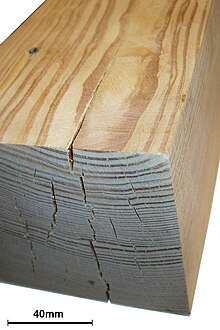Wood anisotropy
Holzanisotropie describes the direction dependence of the properties in the material timber . With wood, a distinction is made between three main anatomical directions. These main directions are growth-related and have a significant influence on mechanical properties, swelling and shrinkage behavior as well as electrical and acoustic conductivity.
Major influencing factors
Wood is a naturally grown organic material. In simplified terms, it can be described as an inhomogeneous , orthotrophic material with three main axes. The properties of different types of wood differ greatly. But the properties within a type of wood are also very variable. The influencing factors on the structure and thus on the properties are diverse. You are e.g. B. depending on tree species, location, growth conditions, age and the history of a tree. In addition to typical growth characteristics such as B. Density , fiber length and fibril angle of the cellulose fibrils in the cell wall, there are also so-called wood defects that have an influence on the anisotropy . Such wood defects are, for example, reaction wood, fiber deviations and eccentric growth. Properties in which wood behaves anisotropically are elasticities, strengths, electrical conductivity, acoustic properties, hardness, swelling and shrinking behavior. Wood is also a hygroscopic material, it can absorb and release water. The properties of the material depend heavily on the wood moisture . The degree of moisture in the wood can influence and reinforce the anisotropic character of the material.
Main anatomical directions
In a very simplified way, wood is divided into three main directions. These are aligned "longitudinally" along the axis of the trunk (parallel to the fiber), "radially" at 90 ° to the annual ring position and "tangentially" as a tangent along the annual rings. The inclination between the annual rings is usually not taken into account. These cutting directions significantly influence the properties of the material.
Affected properties
Swelling and shrinking behavior
Changes in humidity within the hygroscopic range lead to dimensional changes. The wood swells when water is absorbed and shrinks when water is released. This swelling and shrinking behavior depends on the type of wood and differs significantly in the three main anatomical directions. While the maximum change in the fiber direction is 0.1 to 0.6%, the change in the radial direction is 10 to 20 times and in the tangential direction 15 to 30 times as strong as in the fiber direction.
Wood that is used in construction is usually kiln-dried . During this drying process, due to the anisotropic shrinkage of the material, tensions arise in the wood. These tensions can lead to cracks and further drying errors if improperly dried . In order to prevent defects in wood and furniture construction, installation moisture and construction measures must be taken into account that do justice to the anisotropic behavior.
Wood-based materials represent a possibility of equalizing the anisotropic change in dimension of the wood. Wood-based materials are created by breaking down the wood and then putting the resulting parts together appropriately. In the case of plywood, for example, layers of veneer are glued together crosswise. The fibers in the longitudinal direction of one veneer layer prevent the fibers in the transverse direction of the adjacent veneer layer from swelling or shrinking.
Thermal expansion
Compared to the swelling and shrinking behavior, the thermal expansion is relatively low. In the case of floor coverings in combination with underfloor heating, however, this behavior can be relevant as the areas involved are large. The thermal expansion of solid wood is, depending on the type of wood, parallel to the grain (3.15 to 4) * 10 -6 m / (m * K) and perpendicular to the grain (16 to 40) * 10 -6 m / (m * K)
Water absorption
Wood can absorb liquid water through capillary forces . The speed of water absorption is significantly higher in the direction of the fibers than perpendicular to it. The reason for this is the alignment of the capillaries along the direction of growth. In the living tree, the vessels are used to transport water and substances between the roots and the crown. There are significantly fewer capillary structures perpendicular to the fiber.
Acoustic conductivity
In addition to the bulk density and fiber length, the cutting direction has a significant influence on the speed of sound in wood. While the speed of sound parallel to the fiber is 4800-6000 m / s, it is relatively slow perpendicular to the fiber with 1000-1600 m / s. The sound propagation is faster in the radial direction than in the tangential direction.
Mechanical properties
Strengths
As strength the threshold voltage is in the designated a test specimen breaks under load. Different strengths are defined depending on the application of force. For example, a distinction is made between tensile strength , compressive strength , flexural strength , shear strength and torsional strength . The strength of wood is significantly higher in the direction of the grain than perpendicular to the grain. It is tangentially less than radially. The strength decreases with increasing wood moisture and temperature.
Elastic properties
The elasticity is the property of a body to counteract deformation by external forces. The main anatomical directions have a clear influence on the elastic properties. But the type of wood also has a decisive influence. There are big differences between hardwood and softwood in terms of deformation. For example, while beech deforms most strongly in the tangential direction when subjected to tensile loads, the greatest deformation occurs in spruce at a load angle of 45 ° to the main axes.
See also
literature
- Niemz, P., & Wagenführ, A. (2012). Materials made of wood. Paperback of wood technology, 2.


